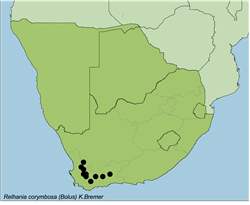Names and synonyms
Relhania corymbosa (Bolus) Bremer
=Nestlera corymbosa Bolus
Type
Bolus 7355, hills near Touws River Railway Station, 2800 ft., 1885 (BOL, K).
Derivation of names
Relhania = after Irish-born Richard Relhan (1754-1823), botanist, plant collector, bryologist, lichenologist, one of the founders of the Linnean Society, rector in Lincolnshire and author of Flora Cantabile.
corymbosa = with (the flowers) in corymbs
Diagnostic characters
Leaves pointing upwards, narrowly obovate to spathulate, tips rounded
Leaves white-woolly above
Capitula small, terminally arranged in small corymbs
Description
A laxly branched, aromatic, sticky, woody, shrublet, 0.3-0.5(-1.2) m high. Stems erect, tomentose, leafy, becoming glabrous and nude and marked with leaf-scars. Leaves spreading, sometimes slightly incurved, with involute margins, narrowly obovate, 6-16 x 0.8-3 mm, sticky, covered in pitted glands, glabrous or tomentose dorsally, densely whitish-hairy above, tips obtuse to rounded. Capitula 3-9 together in terminal cymes. Peduncles 2-6 mm long. Involucre cup-shaped, 2-4 mm wide. Involucral bracts 25-35, outer ovate, inner gradually longer with a spreading, brown, scarious apical limb, dorsally and basally gland-dotted, obtuse-rounded. Receptacle flat-convex, epaleate. Ray florets 7-15, tube 1.5-2 mm long, lamina elliptic, 2-3 x 0.8-1 mm wide, 4-veined. Disc florets 10-25, perfect. Pappus crownlike, of connate scales, sometimes also with a few short barbellate bristles. Cypselas terete, oblong, 1.5-2 x 0.3-0.5 mm wide, glabrous or densely villose in ray florets.
Flowering time
Mainly from October to December.
Distribution
It grows on the Witteberg and further west and north up into the Cederberg.
Known from 20 specimens.
Habitat
In arid fynbos in open low restiod veld, on rocky or stony ridges, also in sandy soil pockets or on flats.
Notes
R. corymbosa is closely related both to R. tricephala and R. relhanioides. It is easily distinguished from R. relhanioides, which has solitary capitula. R. corymbosa as well as R. tricephala have capitula arranged in cymes, but differ in foliage and length of peduncles. The leaves are usually straight or slightly incurved in R. corymbosa and often somewhat twisted in R. tricephala. The pappus of R. corymbosa disc florets usually also have a few barbellate bristles and scales.
References
BREMER, K. 1976. The genus Relhania (Compositae). Opera Botanica 40.
GLEN, H.F. 2004. SAPPI, What's in a Name? The Meanings of the Botanical Names of Trees. Jacana.
KESTING, D. & CLARKE, H. 2008. Botanical names, what they mean. Wild Flowers of the Cape Peninsula, 3rd revised edition. Friends of Silvermine.
